Top News

August 18, 2013 Wu Li Jun of Ryukyu Shimpo of the Ryukyu Shimpo
The number of foreign tourists coming to Okinawa has been increasing for five consecutive months since March. Taiwanese tourists were the largest group, at around 50 percent of the total. Their number has been increasing every month since February. The number of Taiwanese tourists to Okinawa from January to July 2013 amounted to 131,700, which is up 2.2 times on the same period last year.
People involved in the Taiwanese tourism industry expect further increases in demand for travel to Okinawa.
China Airlines currently operates 18 round-trips between Naha and Taipei every week. The number of people using the route from January to June increased by 30 percent over the same period the previous year.
Mandarin Airlines, China Airlines’ regional and domestic subsidiary, operates flights between Ishigaki and Taipei. In addition, China Airlines currently operates 14 flights to Japan. The increase in flights to Tokyo is the highest, followed by those to Okinawa.
Flight reservations between Naha and Taipei in September and October remain at a high-level, being over 80 percent full on average.
Li Yizhou, of the Taipei branch of Mandarin Airlines said, “The cheap yen contributes to the huge increase in demand for Japanese tourism. Okinawa tourism promotion by the Okinawa Convention and Visitors Bureau has also boosted the increase in Taiwanese tourists.”
The South East Travel Service, the largest tourist company in Taiwan, saw the number of people buying Okinawa travel commodities reach a monthly average of 2,000 from January to June, twice that of the same period the previous year.
According to the company, the demand for tourism to resort areas in Southeast Asia has decreased and instead, options closer to Taiwan have gained in popularity. The demand for tourism Okinawa has increased sharply because the prefecture is close to Taiwan and it provides many shopping spots for young people.
Among the Okinawa travel packages sold by the South East Travel Service, the three-day and two-night tour is popular. This sells for about 85,000 yen but before the yen weakened it cost about 90,000 yen. Among travel commodities for other places in the main islands of Japan, four-day and three-night tours are popular.
Tokyo tours are the most popular and cost an average of 100,000 yen.
The cheap yen and Okinawa’s geographical proximity to Taiwan allows for comparatively cheap travel. Trips to Okinawa make Taiwanese customers feel that they are getting value for money.
While the company currently offers five group tours to Okinawa, they also work on sports tourism linked with cycling and marathon events.
Dan Suhui, who is at the Southeast Asia branch of the company, said, “We see ongoing Okinawa tourism promotion by the prefectural government and bureau as important to maintain healthy numbers of inbound Taiwanese tourists. We would like them to promote tourism in the prefecture’s more isolated islands.”
The South East Travel Service plans to create travel commodities to isolated islands to cover a range of needs.
The number of South Korean tourists amounted to 46,100, increasing 2.7 times over the same period the previous year. Those from Hong Kong amounted to 46,200, increasing by 61 percent.
(English translation by T&CT, Mark Ealey)
Go to Japanese
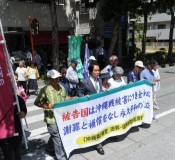
August 15, 2013 Ryukyu Shimpo
War victims in what were formerly as known the Nanyo Gunto (South Sea Islands) during World War II filed a lawsuit with the Naha District Court on August 15. They have sought an apology and damages of 11 million yen per person from the government .The plaintiffs are Okinawan people who were involved in the war and bereaved families. Twenty-four plaintiffs range in age from 67 years old to 101 years old. According to the Okinawa War Victim Group, it is the first time that victims in the former Nanyo Gunto have questioned the government’s responsibility for the war damages.
Seven plaintiffs also joined in the lawsuit to seek an apology and compensation from the government for civilian casualties in the Battle of Okinawa. They filed a lawsuit with the Naha District Court on August 15.
Many plaintiffs took part in the gathering held before they filed the lawsuit. Shigeru Zukeyama, the lead attorney of the War Victim Group said, “The war isn’t over yet in Okinawa where the U.S. is still strengthening its military bases. In seeking an apology and compensation from the government, we would like to reveal the realities of the war and to clarify the damage that occurred in the South Sea Islands.” The lawyer called for the unity among the plaintiffs.
Mitsuo Ara, 75, who is from Palau and lost his brother and sister there, said, “I’ve felt grief and sorrow since their deaths, but I would not act like this if I were alone. Through the lawsuit, I want to let people know about their pain and sufferings of the people who died.” During the war, at least 35,000 Okinawan people died in the Philippines and the South Sea Islands.
(English translation by T&CT, Mark Ealey)
Go to Japanese
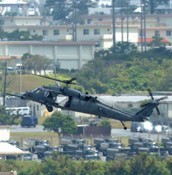
August 17, 2013 Ryukyu Shimpo
Kadena Air Base resumed HH-60 rescue helicopter flights on August 16. The U.S. military had suspended flight training for the HH-60 helicopter after one crashed in the Central Training Area near Camp Hansen in Ginoza on August 5, so only eleven days had passed since the accident. An U.S. Air Force official commented that they are confident in their ability to safely resume operational and training flights, but the cause of the crash remains unclear.
The municipalities, including the Okinawa Prefectural Government, Ginoza Village and Kadena Town, reacted by stating that resumption of the HH-60 flight training is regrettable and unacceptable. At the Japan-U.S. Joint Committee Meeting on August 15, U.S. officials commented that the investigation would take more time to identify the specific cause of the accident.
That day, three HH-60s circled many times over residential areas of Kadena Town. Local residents also saw the helicopters near four U.S. military bases in the northern part of the main island. They carried out intense flight training, including sharp turns. At 9:30 a.m., the helicopters began to turn their rotors in front of the hangars at Kadena Air Base along National Highway No. 58, taking off from the base just before 10:00 a.m. They circled many times over Kadena Town between noon and 1:30 p.m. and by evening had passed over the Furugen district of Yomitan Village and the Hijagawa River towards the sea at least nine times. The helicopters flew over the four districts, including the Central Training Area, where the HH-60 crashed, the Northern Training Area and Blue Beach. People confirmed that the helicopters crossed over Prefectural Road No.70 and flew making sharp turns. By 6:45 p.m., all the helicopters had returned to Kadena Base.
Susumu Matayoshi, the head of the Executive Office of the Governor, commented that resuming HH-60 helicopter’s’ flights was “regrettable.” Kadena Mayor Hiroshi Toyama said, “This is outrageous. We will lodge a firm protest with the U.S. military.”
At the U.S.-Japan Joint Committee meeting, Japanese officials requested that the U.S provide information on the cause of the accident as soon as possible. The U.S side explained that the investigation would take time to identify the specific cause, and that they will strive to provide information quickly to Japan. After the U.S. Air Force releases the results of investigation, officials from both countries’ foreign and defense ministries will discuss the safety of flight operations.
(English translation by T&CT, Mark Ealey)
Go to Japanese

Go To Video
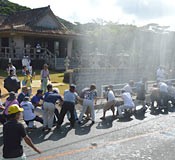
August 12, 2013 Ryukyu Shimpo
For the first time in 15 years, on August 11 at Chinbe dunchi, in Nakachi, Kumejima Town held a ritual calling for rain. Chinbe dunchi is the main place of worship in Kumejima. About 150 residents, including Mayor Choko Taira prayed for rain. The town office said that it had not rained at all since July, and whether or not it was in answer to their prayers, it rained briefly after the ritual.
Noriko Shimabukuro who is a Chinbe, or Okinawan high priestess, offered a prayer for rain at Shuri Bengadaki. She then watered the prayer stone for rain as she walked around it in a counterclockwise direction. There was a tug-of-war held on the road in front of the Chinbe dunchi as people threw water at one another, praying for rain. After that, they conducted rituals for rain at sacred prayer sites such as Shuketsu Utaki and Shiraimi Utaki near the airport. With the prayers at Shiraimi Utaki, they burned straw to pray for rain in front of stones in Hanni saki, which is close to the airport.
The sky became cloudy during the prayers at Shiraimi Utaki. There was a short burst of heavy rain and a whirl like a tornado appeared up in the sky.
Shimabukuro said, “It is marvelous to see this rain. We will keep praying.”
(English translation by T&CT, Megumi Chibana and Mark Ealey)
Go to Japanese
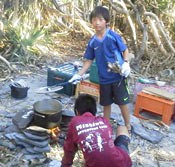
August 15, 2013 Hideaki Yoneda, correspondent of the Ryukyu Shimpo
The National Okinawa Youth Friendship Center held a survival camp for children on an uninhabited island off Tokashiki from July 28 to August 3. Participants from all over the country took part in the camp on Gishippu Island, which is located about 200 meters from the northern end of Tokashiki. The center has held the camp during the summer break each year since opening in 1973.
Without access to electricity, gas or telecommunications on the island, the children experienced the savageness of nature in extreme heat.
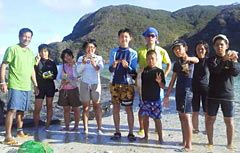
Children collected shellfish with their friends on Gishippu Island off Tokashiki on August 1.
Twenty-four children from the fifth grade of elementary school to the third grade of junior high school took part in the camp. Three came from other prefectures, but 21 were from Okinawa. They came to understand the importance of water and modern amenities and enjoyed experiencing nature on the island.
Rowing a large sabani boat, the children traveled to the island with just a bare minimum amount of food and water. They cooked for themselves by catching fish, making a stone oven and collecting firewood to make a fire.
The children slept out in the open under plastic sheets. Local fisherman Takamitsu Shinzato taught them Okinawan traditional drive-fishing.
Eleven-year-old Sota Nakatani from Osaka said, “I saw baby marine turtles hatching.” Eleven-year-old Takashi Namiki from Sendai, Miyagi, who experienced the Great East Japan Earthquake, said, “I learned the importance of friendship and some practical knowledge for survival.”
Sporting a dark suntan, Ryuta Akamine said, “I’ve become more confident in myself.”
(English translation by T&CT, Mark Ealey)
Go to Japanese
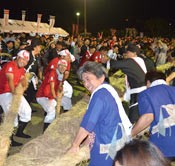
August 18, 2013 Tetsuya Nakajima, correspondent of the Ryukyu Shimpo
The 13th Kumejima Festival revived the island’s great tug-of-war after a gap of 13 years in Hureai Park in Kumejima on August 17. Many locals and people from off the island took part in the event.
The rope used in the tug-of-war was about 90 meters long and weighed five tons. It is said that the origin of the Kumejima great tug-of-war is a tug-of-war held with prayers for rain in drought years. On this occasion, the organizers used the rope from the Yonabaru great tug-of-war. After a tough struggle, the west side won the event.
The rope was placed in front of an open-air stage in the park.
The east and west sides faced off before the male rope for the east side and the female rope for the west side were connected.
Young men dressed as the Ryukyuan lords Gosamaru and Amawari stood on the wooden floor, playing out a Gae performance and yelling to the sound of a trumpet shell, Chinese gong and firecrackers.
After this, they linked the two sections of the rope using a wooden pole called a kanachi bar and the east and west sides started pulling against each other.
A woman visiting from outside of Okinawa, said, “The tug-of-war was a real surprise for me. It was first time for me to see an event like this.” Those who took part each took a piece of the rope for good luck. After the event, there were some brief rain showers so maybe their prayers were answered.
(English translation by T&CT, Mark Ealey)
Go to Japanese
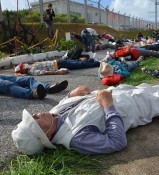
August 13, 2013 Ryukyu Shimpo
On August 13, protesters staged a “die-in rally” in front of Camp Foster, Kitanakagusuku to mark the ninth anniversary of the U.S. marine helicopter crash onto Okinawa International University. About 70 people took part in “Memorial Tuesday,” held from 7:00 a.m. They protested against the additional Osprey and a Kadena-based HH-60 helicopter crash in a “die-in,” a non-violent act, which first appeared in the United States during the 1960s. Tsuyako Shimabukuro, a member of the Okinawan folk music group Deigo Musume, sang the song Kanpo nu Kwe-nukusaa (Leftovers of the Warship) and Okinawa wo kaese (Give Okinawa back to us) at the rally.
People have held a protest rally every Tuesday in front of the Marine base. Tomoyuki Kobashigawa, the 70-year-old organiser of the rally, said, “In our movement we will not raise our fists or yell. We protest against the U.S. forces as an organization, but we respect U.S. soldiers as individuals.”
They placed a piece of art by Kobashigawa that represents a helicopter crash in Okinawa International University and decorated it with flowers. Participants observed a moment of silence after they sang a chorus of song Satoukibi Batake (Sugar Cane Fields).
(English translation by T&CT, Mark Ealey)
Go to Japanese
University President seeks to close Futenma immediately
August 13, 2013 Ryukyu Shimpo
August 13 is the ninth anniversary of a U.S. military helicopter crashing onto Okinawa International University. A gathering was held in front of the monument where the helicopter crashed. University President Tamotsu Oshiro called for the United States and Japanese governments to close the base at Futenma immediately and return the land. He stressed that Futenma has become the most dangerous base in existence, and referred to the additional deployment of the Osprey and incidents involving the military. Two students also expressed their views on the Futenma issue.
(English translation by T&CT, Mark Ealey)
Go to Japanese
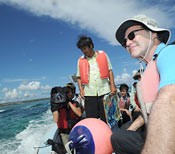
August 15, 2013 Futoshi Hanashiro of Ryukyu Shimpo
American film director Oliver Stone arrived in Okinawa on August 13. That day, he visited Okinawa International University, which marked nine years since the U.S. military helicopter crashed onto its campus. On August 14, Stone also visited the Henoko district of Nago, where the U.S. and Japanese governments plan to build an alternative facility to Futenma Air Station. Meeting people involved in the university and representatives of citizen groups, Stone displayed a strong interest in the U.S. military base issues in Okinawa. The Ryukyu Shimpo introduces Stone’s two-day visit to Okinawa with photographs.
(English translation by T&CT, Mark Ealey)
Go to Japanese

Stone (second from left) visited the Cornerstone of Peace monument to read the names of the war dead from various countries inscribed on monuments. Peter Kuznick (far left) and Satoko Norimatsu (far right) accompanied him. Masaie Ishihara, professor emeritus at Okinawa International University provided an explanation for them. In Mabuni, Itoman, at around 10:30 a.m. on August 14.

At Peace Memorial Park to listen to an explanation in front of the Peace Flame at Mabuni, Itoman at around 10:36 a.m. on August 14.

Viewing artworks such as THE BATTLE OF OKINAWA at Sakima Art Museum in Ginowan at 6:06 p.m. on August 13.

Looking around inside the cave of Todoroki in Ishiki, Itoman at around 10:06 a.m.

Watching Battle of Okinawa footage at the Okinawa Prefectural Peace Memorial Museum in Mabuni, Itoman at 11:26 a.m. on August 14.

Stone looked at panels that depict scenes from the Battle of Okinawa at the Okinawa Prefectural Peace Memorial Museum in Mabuni, Itoman at around 11:33 a.m. on August 14.
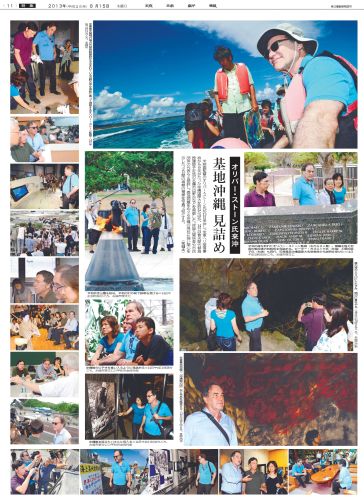
Click to enlarge (PDF)
Slideshow of Oliver Stone visits Okinawa(Please click the picture below)
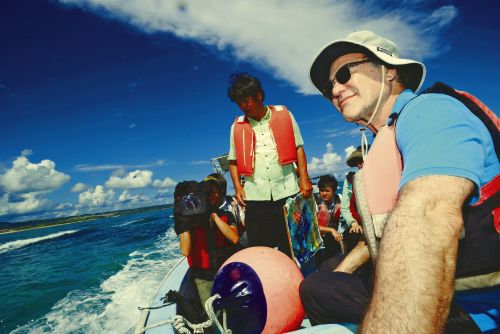
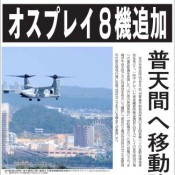
August 12, 2013 Ryukyu Shimpo
In the morning of August 12, the U.S. Marine Corps resumed the deployment of additional MV-22 Osprey to Futenma Air Station. The U.S. military suspended this, considering the reaction of Okinawan residents after a Kadena based HH-60 rescue helicopter crashed in Ginoza. Of the remaining ten Osprey aircraft at the Iwakuni Air Station in Yamaguchi, eight took off from the base one after another from 8:00 a.m., with the first two aircraft arriving at Futenma at 10:15 a.m. Eight had landed by 10:23 a.m.
The Marines announced at 7:00 a.m. on August 12 that in close coordination with the Japan government, the decision had been made to resume the deployment of MV-22 Osprey aircraft, and that the aircraft and crew were scheduled to begin arriving today at Futenma. The Okinawa Defense Bureau told the municipalities, including the Okinawa Prefectural Government and Ginowan City.
The U.S. military moved two of the additional 12 aircraft to Futenma on August 3 and announced that the other ten would arrive in Okinawa from Iwakuni on or after August 5. However, when the helicopter crash occurred on August 5 the Japanese government asked the U.S. to temporarily suspend the additional deployment, which the U.S. agreed to. A squadron of 12 Osprey aircraft arrived at Iwakuni from the United States on July 30, and the Marine Corps had planned to move them to Okinawa from that point on.
The Marine Corps emphasizes that the performance of the MV-22, including its range and speed, is significantly better than its predecessor, the CH-46 Medium Transport helicopter. However, concerns about its safety have remained because of several crashes during and since the aircraft’s development stage.
(English translation by T&CT, Mark Ealey)
Special edition of Ryukyu Shimpo news on August 12
Go to Japanese

Go To Video
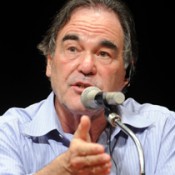
August 15, 2013 Ryukyu Shimpo
The Ryukyu Shimpo invited two-time Academy Award-winning director Oliver Stone to an event celebrating the 120th anniversary of the establishment of the newspaper at the theater in the Okinawa Convention Center in Ginowan. Okinawa Television supported the event, which was held in the evening of August 14.
Stone said the U.S. military bases in Okinawa are reminiscent of the Cold War-era, and that the war still seems to continue in the relationships between the United States, Japan and Okinawa. He questioned the continuing existence of the military bases 20 years after the end of the Cold War.
Before the event, Stone visited the Henoko district of Nago, where the U.S. and Japanese governments plan to build an alternative facility to Futenma Air Station. He opposes the plan to reclaim an area of sea off Henoko, which he described as hosting bounteous amounts of coral and marine life. He said that he is embarrassed that the U.S. military is to build a new base that could destroy the area and make it ugly, negatively affecting Okinawan culture.
Stone voiced his concern about the continuing presence of the bases more than 60 years after the end of the war and about the Henoko land reclamation. He said that seeing China as a threat only serves to create tension in Asia.
Peter Kuznick, professor of history at American University, Masahide Ota, former Okinawa Governor and Satoko Norimatsu, director of the Peace Philosophy Centre
took part in a panel discussion with Stone.
Stone and Kuznick criticized U.S. hegemonism, saying that while they claim to do so, the U.S. government has not reduced the excessive burden on Okinawa of hosting U.S. military bases. The two asserted presidents and politicians cannot be trusted because the government does not tell the truth.
The event attracted 1,700 people, who listened attentively to Stone and the other panelists.
After Stone and his companions held a press conference at the Ryukyu Shimpo in Ameku, Naha in the morning of August 15 they departed from Naha Airport.
(English translation by T&CT, Mark Ealey)
Go to Japanese

Go To Video
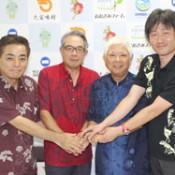
August 8, 2013 Ryukyu Shimpo
In October, the largest plant factory in Okinawa, that could produce 800,000 lettuce leaves per year, will start operating in Ogimi Village. On August 7, Ogimi Farm, which manages the factory, held a press conference to explain the establishment at a rental incubation factory at the Yui no Hama, a reclaimed area of Shioya Bay in Ogimi.
Using the mineral-rich spring water of Ogimi Village, they will cultivate plants hydroponically or in planters without chemical fertilizer. Of 15 full-time and part-time employees, they intend to hire 11 people with disabilities.
The general construction consultant Oba Group put in 100% of the funds invested in Ogimi Farm. The conference was attended by Akinori Oba, president of the Oba Group, Koichi Fuchikami, president of Ogimi Farm, Ogimi Mayor Yoshihisa Shimabukuro, and Naoya Hamabata, president of Espere, which has carried out support projects for people with disabilities in Nago and dispatched contract employees.
According to Fuchikami, three rooms with eight shelves and 12 rows planting shelve are set up in about 1,300 square meters of factory. At the beginning they will focus on growing leaf vegetables in planters and hydroponics at a 1-2 ratio respectively. The company adopted planter cultivation without using chemical fertilizer, with improved soil, which it developed itself.
They aim to achieve annual sales of 100 million yen by supplying vegetables to hotels and supermarkets. Fuchikami said, “We would like to respond to the needs of smaller restaurants, including for vegetables not produced in Okinawa.”
Rental factory space in Yui no Hama was all taken up after the company moved in. Mayor Shimabukuro said, “Making full use of Ogimi’s bountiful water supplies, I hope that the Ogimi brand of vegetables will become known in the outside world.”
(English translation by T&CT, Megumi Chibana and Mark Ealey)
Go to Japanese























 Webcam(Kokusai Street)
Webcam(Kokusai Street)


